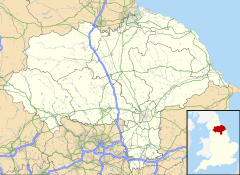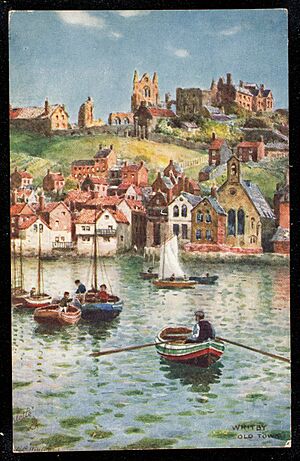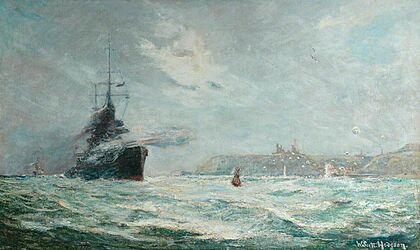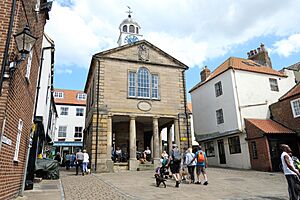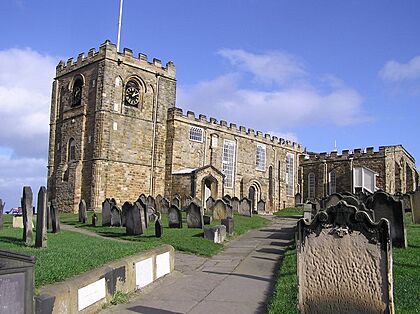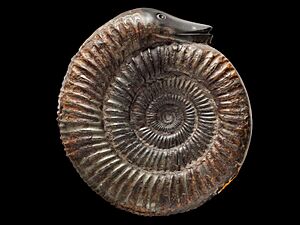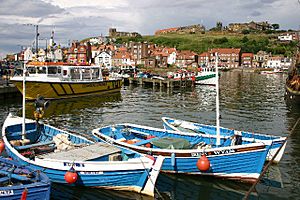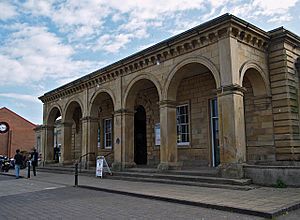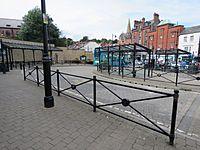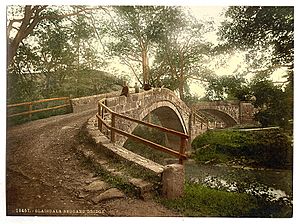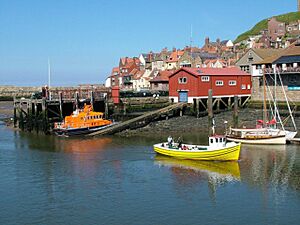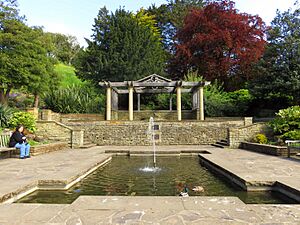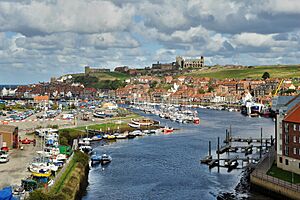Whitby facts for kids
Quick facts for kids Whitby |
|
|---|---|
| Town | |
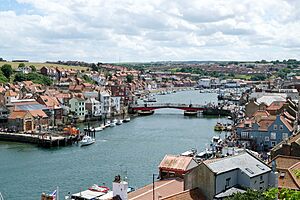 View of Whitby from the West Cliff |
|
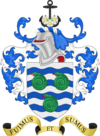 Arms of Whitby Town Council featuring three green serpents (prior to 1935 depicted as ammonites). |
|
| Population | 13,213 (2011 census) |
| OS grid reference | NZ893109 |
| Civil parish |
|
| Unitary authority |
|
| Ceremonial county | |
| Region | |
| Country | England |
| Sovereign state | United Kingdom |
| Post town | WHITBY |
| Postcode district | YO21, YO22 |
| Dialling code | 01947 |
| Police | North Yorkshire |
| Fire | North Yorkshire |
| Ambulance | Yorkshire |
| EU Parliament | Yorkshire and the Humber |
| UK Parliament |
|
Whitby is a cool seaside town and port in North Yorkshire, England. It sits right on the Yorkshire Coast where the River Esk meets the sea. Whitby is known for its history with ships, mining, and tourism.
For hundreds of years, Whitby was a busy place for catching herring fish and hunting whales. It's also where the famous explorer Captain Cook learned how to sail. His ship, HMS Endeavour, which he used to explore the southern ocean, was built right here in Whitby!
A mineral called Alum was mined nearby. Also, beautiful black jet jewellery from Whitby was very popular in the 1800s.
People started visiting Whitby for holidays in the 1700s. Tourism really grew when the railway arrived in 1839. The old abbey ruins on the East Cliff are the town's oldest and most famous landmark. Other cool spots include the swing bridge over the River Esk and the safe harbour with its east and west piers. You can also see statues of Captain Cook and William Scoresby, plus a big whalebone arch on the West Cliff. Whitby is even famous for being in books, like Bram Stoker's novel Dracula.
Whitby is about 47 miles (76 km) from York and 22 miles (35 km) from Middlesbrough.
Contents
- Whitby's Past: A Journey Through Time
- How Whitby is Governed
- Religion in Whitby
- Whitby's Geography and Nature
- Whitby's Economy: Fishing, Tourism, and More
- Getting Around Whitby
- Public Services in Whitby
- Education in Whitby
- Famous Landmarks in Whitby
- Culture and Media in Whitby
- Sports and Activities in Whitby
- Whitby's Climate
- Whitby's Population
- Famous People from Whitby
- Whitby's Twin Towns
- See also
Whitby's Past: A Journey Through Time
Early Names and the First Monastery
Whitby had many names long ago, like Streanæshalc and Prestebi. The name Prestebi came from Old Norse words meaning "village of the priests." Later, in the 1100s, it was called Hwitebi or Witebi. These names came from Old Norse words meaning "white village."
A monastery was started in 657 AD by King Oswiu of Northumbria. He built it to say thank you after winning a battle. This monastery was special because it was for both men and women. Its first leader was a royal princess named Hild, who later became a saint. The monastery was a place for learning. A cowherd named Cædmon became a famous poet there, writing amazing Anglo-Saxon poems.
In 664, an important meeting called the Synod of Whitby happened here. It decided that Northumbria would follow the Roman way of calculating Easter, instead of the Celtic way.
Viking Raids and New Beginnings
Sadly, Vikings from Denmark attacked and destroyed the monastery between 867 and 870. The area was empty for over 200 years. After the Normans conquered England in 1066, the land was given to William de Percy. In 1078, he gave land to start a new monastery. This one was for Benedictine monks and was dedicated to St Peter and St Hilda. William de Percy also gave them land for the town, the port, and St Mary's Church.
In 1086, the Domesday Book showed that Whitby was mostly empty and a small settlement. This was because William the Conqueror's army had caused a lot of damage during the Harrying of the North in 1069–70.
Around 1128, King Henry I gave the abbey permission to hold a fair in Whitby. This helped the town grow.
Whaling, Cook, and Changes

Whitby Abbey closed down in 1539 when King Henry VIII shut down all the monasteries. By 1540, the town had only about 20 to 30 houses and around 200 people.
At the end of the 1500s, Thomas Chaloner saw how alum was made in Italy. He noticed that the rocks there were like the ones on his land near Guisborough. Alum was very important for medicine, treating leather, and fixing dyes on cloth. Chaloner secretly brought workers to Yorkshire to start making alum. This made England able to produce its own alum.
Whitby became a much bigger port because of the alum trade. Ships brought coal from Durham to help process the alum. The town also grew by building ships using local oak wood. In 1790–91, Whitby built so many ships that it was the third-largest shipbuilding place in England!
In 1753, the first whaling ship sailed from Whitby to Greenland. By 1795, Whitby was a major whaling port. The best year was 1814, when eight ships caught 172 whales. The oil from these whales was used in lamps. Whale bones were used for corsets until fashions changed. As the demand for whale products dropped, whaling became less profitable. By 1831, only one whaling ship was left.
Whitby was important for trade between the coal mines of Newcastle and London. Young James Cook learned to sail on coal ships from Whitby. His famous ship, HMS Endeavour, was built in Whitby in 1764 as a coal carrier. The Royal Navy bought it in 1768, changed it, and renamed it.
Whitby also became a spa town in the 1700s. People came to drink from its special springs, which were thought to be good for health. This led to many hotels and guesthouses being built, especially on the West Cliff.
Trains and Jet Jewellery
In 1839, the Whitby and Pickering Railway opened, connecting Whitby to Pickering and later to York. This railway helped Whitby become a popular place for tourists.

The black mineral called jet is found in the cliffs and moors around Whitby. It's made from ancient trees. People have used it since the Bronze Age to make beads. In Victorian times, jet was brought to Whitby to be made into beautiful jewellery. It was most popular in the mid-1800s, especially after Queen Victoria wore it for mourning after her husband, Prince Albert, died.
As iron ships became popular in the late 1800s, smaller harbours like Whitby's declined. The last wooden ship built in Whitby was launched in 1871.
The 1900s and Today
On October 30, 1914, a hospital ship called the Rohilla sank near Whitby. Many people died in this sad event.
In December 1914, during World War I, German warships shelled Whitby. The attack lasted ten minutes, and Whitby Abbey was badly damaged.
In the early 1900s, fishing kept the harbour busy. In 1964, a new wharf was opened near the railway station. This helped the port grow, and more ships started using it. Today, timber, paper, and chemicals are imported, while steel and other goods are exported.
A marina was built starting in 1979, making the harbour a great place for pleasure boats. More parts of the marina were finished in the 1990s.
How Whitby is Governed
| Whitby Town Council | |
|---|---|
| Type | |
| Type |
Town Council
|
| Leadership | |
|
Mayor
|
Robert Dalrymple
|
|
Town clerk
|
Michael King
|
| Seats | 19 Councillors |
| Elections | |
|
Last election
|
2 May 2023 |
|
Next election
|
7 May 2027 |
| Meeting place | |
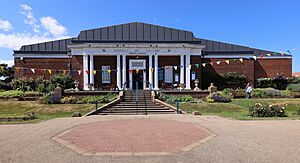 |
|
| Whitby Museum | |
Since 1837, the town has been run by a group of elected officials called Improvement Commissioners. Later, a Local Board was formed in 1872.
From 1974 to 2023, Whitby was part of a two-level council system. Scarborough Borough Council handled things like housing and planning. Above that, North Yorkshire County Council managed education and transport.
In April 2023, these two councils were replaced by one big council called North Yorkshire Council. This new council now handles all the services for the area.
Whitby also has its own town council. This council has 19 councillors who look after local things like burial grounds, play areas, and street lighting.
In the UK Parliament, Whitby is represented by Alison Hume from the Labour Party. She was elected in 2024.
Religion in Whitby
In the Whitby area, most people identify as Christian. There are also smaller numbers of Muslims, Buddhists, and Jews. Many people have no religious ties.
St Mary's Church is very old. Other churches include St Ninian's, St John's, St Michael's, and St Hilda's. There is also a Catholic church dedicated to St Hilda. Whitby has places of worship for other Christian groups too. The Mission to Seafarers helps sailors with Christian support.
The Bishop of Whitby is a special bishop in the Church of England. Whitby is also part of the Roman Catholic Diocese of Middlesbrough.
Whitby's Geography and Nature
Whitby is on the east coast of Yorkshire, facing the North Sea. It sits in a deep valley where the River Esk meets the sea. A swing bridge, built in 1908, crosses the river. This bridge opens to let ships pass between the upper and lower harbours. The town's houses are made of brick or stone, often with red roofs, and are built on narrow, steep streets on both sides of the river.
The North York Moors National Park surrounds Whitby on the land side. The coast is part of the North Yorkshire and Cleveland Heritage Coast.
The cliffs on the east side are tall, about 187 feet (57 m) high. They are made of layers of shale, sandstone, and clay. The west cliff is lower and less stable. Both cliffs are slowly being worn away by the sea.
Fossils and Snakestones
Whitby is part of the "Dinosaur Coast" or "Fossil Coast," which is about 35 miles (56 km) long. You can even see dinosaur footprints on the beach! The rocks here contain many fossils, including jet. Fossils found include crocodile bones and a plesiosaurus that was 15 feet 6 inches (4.72 m) long. The Rotunda Museum in Scarborough has a great collection of fossils from this area.
Smaller fossils include many types of ammonites, which people call "snake stones." Local stories say that these fossils were once living snakes. The legend says that St Hilda of Whitby turned them into stone and threw them off the cliffs.
To make them more interesting, fossil collectors often carved heads onto the ammonites. Since 1935, the Whitby Coat of Arms even includes three snakestones because of this old story. A type of ammonite, Hildoceras, is named after St Hilda.
Whitby's Economy: Fishing, Tourism, and More
Whitby's economy mainly relies on tourism and fishing. The town is a bit isolated, and building is limited by the surrounding North York Moors National Park. This means that jobs can be limited, and some younger people leave the area. However, older people often move here.
The town has many places to stay, like holiday cottages, campsites, and hotels. The jet industry isn't as big as it used to be, but you can still find shops selling jet jewellery to tourists. Whitby has won awards for being a great seaside resort.
The harbour is used by commercial ships, fishing boats, and pleasure boats. Fishing for lobsters, crabs, and other fish is important here. From May to August, salmon are caught in the Esk River. There are also many boats for fishing trips. The main commercial catch is now cod and haddock, not herring. A fish market on the quayside sells fresh fish. Because of the fresh fish, Whitby has many famous "chippies" (fish and chip shops), including the Magpie Cafe.
The Whitby Marina project was built to help the local economy grow. Parkol Marine, a family-run shipbuilding company, is still active on the east side of the river. They build new boats and repair old ones. Whitby also has a business park with companies like Supreme Plastics and Whitby Seafoods Ltd.
Whitby is also a good location for supporting the offshore wind power industry. A huge wind farm is planned on Dogger Bank, and Whitby could be a base for ships and supplies.
Getting Around Whitby
Port and Shipping
Whitby's port is used for shipping goods to Europe, especially Scandinavia. It mainly handles grain, steel, timber, and potash. Ships up to 3,000 tonnes can dock here. There's a large dock space for storing cargo.
Trains
Whitby railway station is the end of the Esk Valley Line from Middlesbrough. You can catch trains run by Northern here.
In summer, the North Yorkshire Moors Railway runs steam trains between Pickering and Whitby. It's a fun way to see the countryside.
The Scarborough and Whitby Railway used to run along the coast. It closed in 1965. Now, its old track is a path for walking, cycling, and horse riding.
Roads and Buses
Whitby is on the A171 road which goes from Scarborough to Guisborough. A high bridge was built in 1980 to help traffic avoid the swing bridge in the town centre. The A174 goes to coastal towns north of Whitby, and the A169 crosses the North York Moors.
Whitby is on the Yorkshire Coastliner bus route, connecting it to places like Leeds, York, and Scarborough. Arriva North East also runs bus services to Scarborough and Middlesbrough.
Walking Trails
The Cleveland Way National Trail, a long walking path, passes through Whitby. It's a great way to explore the coast.
Public Services in Whitby
Whitby Community Hospital is being redeveloped into a "health and wellbeing hub." It will have an urgent care centre and beds for patients.
There are five doctors' offices and five dentists in the Whitby area.
The Yorkshire Ambulance Service provides emergency medical transport.
Whitby fire station is staffed by the North Yorkshire Fire and Rescue Service during the day. The town also has two police stations.
The Whitby Lifeboat Station is run by volunteers from the Royal National Lifeboat Institution. They have two lifeboats to rescue people at sea.
North Yorkshire County Council handles waste collection and recycling. Yorkshire Water provides water and sewerage services. Electricity is supplied by CE Electric UK, and gas by Northern Gas Networks.
Education in Whitby
Whitby has a three-tier school system: primary, middle (ages 11–14), and Caedmon College (ages 11–19). Caedmon College was formed in 2014 by combining two older schools. Eskdale School is also a middle school.
The primary schools in Whitby are St Hilda's Roman Catholic Primary School, Stakesby Community Primary School, West Cliff Primary School, Airy Hill Community Primary School, and East Whitby Community Primary School.
The Whitby and District Fishing Industry Training School offers courses for people who want to work in the fishing industry.
Famous Landmarks in Whitby
The swing bridge over the Esk River connects the east and west sides of Whitby. It opens to let ships pass. This bridge has been rebuilt several times over the centuries. The current electric swing bridge was built between 1908 and 1909.
On the east side of the river, the Haggerlythe, you'll find St Mary's Church and the ruins of Whitby Abbey. St Mary's Church is a very old building, dating back to the 1100s. To get to the church and abbey from the town, you can climb the 199 steps known as the "Church Stairs." These stone steps were built about 200 years ago.
| Location | Whitby North Yorkshire England |
|---|---|
| Tower shape | cylindrical tower with balcony and lantern |
| Characteristic | occasionally F G |
| Fog signal | 1 blast every 30s |
| Location | Whitby North Yorkshire England |
|---|---|
| Tower shape | cylindrical tower with balcony and lantern |
| Fog signal | 1 blast every 30s |
The harbour is protected by the east and west piers, each with a lighthouse. The west lighthouse is taller, at 84 feet (25.5 m). The east lighthouse is 54 feet (16.5 m) high. On the west pier, there's a foghorn that sounds every 30 seconds when it's foggy.
On the West Cliff, there's a statue of Captain James Cook, who trained in Whitby. A large whalebone arch remembers the town's whaling history. There's also a statue of William Scoresby Sr., who invented the crow's nest for ships.
Just outside town to the west is Sneaton Castle, built in the 1800s. It's now a conference centre and hotel.
Culture and Media in Whitby
Frank Meadow Sutcliffe took many photos of Whitby, its harbour, fishing, and people in the late 1800s. His most famous photo is "Water Rats," taken in 1886. He was known worldwide for his amazing photography. He won over 60 medals for his work. After he retired, he became the curator of Whitby Museum. You can see his photos in a gallery on Flowergate.
Pannett Park was created on land bought by a local leader named Robert Pannett in 1902. After he died, a trust he set up created a public park and art gallery. In 1931, Whitby Museum was built behind the gallery. It has a collection of jet history and even a "Hand of Glory" on display.
Whitby has had a lifeboat since 1802. The old boathouse, built in 1895, is now a museum. It displays the Robert and Ellen Robson lifeboat.
The ancient Penny Hedge ceremony happens every year. It remembers a punishment given to hunters in the Middle Ages. They had to cut wood with a penny knife and build a hedge in Whitby harbour that would last for three tides. This tradition is still carried out today.
The Whitby Gazette newspaper was started in 1854. It's now a weekly newspaper. Local radio stations include BBC Radio Tees and This is The Coast.
The Pavilion Theatre hosts many events in the summer. Whitby also has the Whitby Folk Week and the bi-annual Whitby Goth Weekend. "Whitby Now" is a yearly music event. Since 2008, the Bram Stoker Film Festival has taken place in October.
Whitby in Books and TV
Whitby has a strong connection to literature. Cædmon, the first known Anglo-Saxon poet, was a monk at Whitby Abbey. Part of Bram Stoker's famous novel Dracula is set in Whitby. Stoker found the name "Dracula" in the old public library here.
Elizabeth Gaskell's novel Sylvia's Lovers is partly set in Whitby. Lewis Carroll, who wrote Alice in Wonderland, stayed in Whitby in 1854.
Charles Dickens visited Whitby. He wrote a letter about the "curious railroad" and the town's old inn. Wilkie Collins also stayed in Whitby while working on his novel No Name.
Mary Linskill, a writer, was born in Whitby in 1840. Her novel Between the Heather and the Northern Sea was very popular. James Russell Lowell, an American writer, loved Whitby and visited many times.
G. P. Taylor, a former church leader in Whitby, is now a famous author. His book Shadowmancer is set in Whitby. Theresa Tomlinson, who writes for children and young adults, lives in the town.
The novel Possession: A Romance by A. S. Byatt is set in Whitby. It was made into a movie in 2002.
The British TV show Heartbeat often features Whitby. A crime novel series by James Whitworth is also set in Whitby.
A trilogy of young adult novels, The Whitby Witches, uses the town's setting and history. The author, Robin Jarvis, said Whitby was a "fantastic inspiration."
Sports and Activities in Whitby
People enjoy windsurfing, sailing, and surfing off the beaches near Whitby. Divers also visit the area. Whitby has cricket and football pitches, and tennis courts.
The Whitby Regatta is an annual event in August. The main part is a rowing competition between local clubs.
Whitby Golf Club has an 18-hole course on the cliffs since 1895.
Whitby Town F.C., a semi-professional football club, plays at the Turnbull Ground. Whitby Cricket Club also plays here.
Whitby's Climate
Whitby generally has warm summers and mild winters. The weather changes often. It's influenced by winds from the west, which bring unsettled weather, especially in winter. Sometimes, there are periods of clear, fine weather.
The North York Moors protect Whitby from the worst of the wet westerly winds. The nearby North Sea also affects the climate. Springs can be chilly, and summers are warm. Sometimes, in spring and early summer, winds from the sea bring mists or low clouds, known as "sea frets," to the coast.
| Climate data for Whitby, elevation: 41 m (135 ft), 1991–2020 normals, extremes 1961–present | |||||||||||||
|---|---|---|---|---|---|---|---|---|---|---|---|---|---|
| Month | Jan | Feb | Mar | Apr | May | Jun | Jul | Aug | Sep | Oct | Nov | Dec | Year |
| Record high °C (°F) | 14.8 (58.6) |
19.6 (67.3) |
20.0 (68.0) |
25.0 (77.0) |
25.6 (78.1) |
30.9 (87.6) |
29.9 (85.8) |
33.1 (91.6) |
27.9 (82.2) |
28.0 (82.4) |
17.8 (64.0) |
16.2 (61.2) |
33.1 (91.6) |
| Mean daily maximum °C (°F) | 7.3 (45.1) |
7.9 (46.2) |
9.8 (49.6) |
12.0 (53.6) |
14.7 (58.5) |
17.6 (63.7) |
19.9 (67.8) |
19.7 (67.5) |
17.3 (63.1) |
13.8 (56.8) |
10.1 (50.2) |
7.7 (45.9) |
13.1 (55.6) |
| Daily mean °C (°F) | 4.7 (40.5) |
5.1 (41.2) |
6.5 (43.7) |
8.4 (47.1) |
11.0 (51.8) |
13.8 (56.8) |
16.1 (61.0) |
16.0 (60.8) |
13.8 (56.8) |
10.7 (51.3) |
7.4 (45.3) |
5.1 (41.2) |
9.9 (49.8) |
| Mean daily minimum °C (°F) | 2.2 (36.0) |
2.3 (36.1) |
3.2 (37.8) |
4.8 (40.6) |
7.3 (45.1) |
10.1 (50.2) |
12.2 (54.0) |
12.2 (54.0) |
10.3 (50.5) |
7.7 (45.9) |
4.7 (40.5) |
2.4 (36.3) |
6.6 (43.9) |
| Record low °C (°F) | −11.8 (10.8) |
−10.5 (13.1) |
−12.5 (9.5) |
−7.0 (19.4) |
−2.3 (27.9) |
0.3 (32.5) |
1.9 (35.4) |
3.0 (37.4) |
0.5 (32.9) |
−3.0 (26.6) |
−8.7 (16.3) |
−19.6 (−3.3) |
−19.6 (−3.3) |
| Average precipitation mm (inches) | 57.5 (2.26) |
46.4 (1.83) |
39.2 (1.54) |
44.4 (1.75) |
38.8 (1.53) |
57.6 (2.27) |
49.1 (1.93) |
61.3 (2.41) |
53.3 (2.10) |
58.9 (2.32) |
71.0 (2.80) |
66.7 (2.63) |
644.1 (25.36) |
| Mean monthly sunshine hours | 60.9 | 87.7 | 129.8 | 167.5 | 211.4 | 194.0 | 202.5 | 188.2 | 145.7 | 108.2 | 70.3 | 55.7 | 1,622 |
| Source 1: Met Office | |||||||||||||
| Source 2: Starlings Roost Weather | |||||||||||||
On January 5, 2016, Whitby was hit by flash floods. Police warned drivers to be very careful.
Whitby's Population
According to the 2011 UK census, Whitby parish had 13,213 people living in 6,097 homes. Most homes were owned, and some were rented.
About 2,500 people were under 16, and 2,700 were 65 or older. The average age was about 41.78 years. Many people travel to work by car, but some households don't have cars.
How Whitby's Population Has Changed Over Time
| Year | 1801 | 1811 | 1821 | 1831 | 1841 | 1851 | 1861 | 1871 | 1881 | 1891 | 1901 | 1911 | 1921 | 1931 | 1939 | 1951 | 1961 | 1971 | 1981 | 1991 | 2001 | 2011 | 2021 |
|---|---|---|---|---|---|---|---|---|---|---|---|---|---|---|---|---|---|---|---|---|---|---|---|
| Whitby CP | 8,125 | 7,886 | 8,820 | 7,501 | 6,349 | 5,879 | 5,811 | ||||||||||||||||
| Ruswarp CP | 3,141 | 4,236 | 4,839 | 5,097 | 5,019 | 4,831 | 6,195 | ||||||||||||||||
| Helredale CP | 387 | 411 | 504 | ||||||||||||||||||||
| Hawsker CP (part) | 590 | 665 | 741 | 816 | 79 | 79 | 79 | ||||||||||||||||
| Population | 10,974 | 10,275 | 12,584 | 11,725 | 11,682 | 12,875 | 11,856 | 12,787 | 14,400 | 13,414 | 11,834 | 11,218 | 12,589 | 11,451 | 12,698 | 11,674 | 11,675 | 12,327 | 12,980 | 13,632 | 13,594 | 13,213 | 13,129 |
|
Whitby CP/AP |
|||||||||||||||||||||||
Note: Between 1801 and 1925 Whitby included several smaller areas. These were all combined into the current Whitby area on April 1, 1925.
Famous People from Whitby
- Samuel Barnett (born 1980), an actor.
- William Bateson (1861–1926), a geneticist, was born in Whitby.
- Arthur Brown (born 1942), a musician.
- William Clarkson (1859–1934), who helped start the Royal Australian Navy.
- Hilda of Whitby (c. 614 – 680), an early Christian saint.
- Adam Lyth (born 1987), a cricketer who played for England.
- Beth Mead (born 1995), a footballer born in the town.
- Mark Richardson (born 1970), a drummer who grew up in Whitby.
Whitby's Twin Towns
Whitby has "twin towns" around the world. Many of them were visited by Captain Cook in ships built in Whitby.
- Anchorage, Alaska, United States
- Porirua, New Zealand
- Stanley, Falkland Islands
- Whitby, Canada
- [[Nukuʻalofa|Nukuʻalofa]], Tonga
- Kauai County, Hawaii
- Osterode, Germany
|
See also
 In Spanish: Whitby para niños
In Spanish: Whitby para niños


